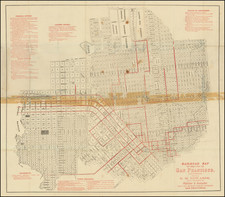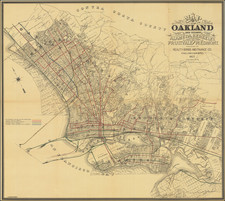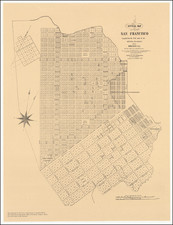The First Residence Built in Burlingame, California
Attractive hand-colored G.T. Brown lithograph of the Residence of John Donnelly in Burlingame (then part of San Mateo), from Moore & De Pue's Illustrated History of San Mateo County.
John Donnelly is generally regarded as the first permanent resident in what would become Burlingame, California. The San Mateo area became more accessible after the San Francisco and San Jose Railroad began running trains down the Peninsula in 1863. By the mid-1870s, Minnesota-born John Donnelly, likely Burlingame’s earliest permanent resident, had built a home at the corner of Burlingame Avenue and Primrose Road on 4.5 acres which purchased from landowner William Corbitt. Corbitt was the owner of the San Mateo Stock Farm horse breeding ranch, which was located on today’s Burlingame High School site. In 1875, famed landscape architect John McLaren began planting trees, most of which still stand, to line the county road (El Camino Real) and to mark the perimeters and entrances to the country estates of Ralston (in Belmont) and Howard, Easton and Mills (in San Mateo, Burlingame and Millbrae).
John Donnelly was one of Corbitt’s carpenters. In exchange for services, Corbitt gave him the property on Burlingame Avenue at Primrose. Donnelly’s home and two additional homes belonging to his children occupied the space north of Burlingame Avenue between today’s Primrose Road and Park Road. Donnelly’s home, set back on the lots near today’s Donnelly Avenue, lasted into the 1960s.
G.T. Brown
Grafton Tyler Brown is perhaps the first and unquestionably the most famous African American artist and lithographer to depict California and the Pacific Coast. Born in Harrisburg, Pennsylvania, February 22, 1841, Brown moved to San Francisco at the age of 20 and learned the art of lithography from C. C. Kuchel. In 1861 and again in 1864, Brown created the two earliest bird's eye views of Virginia City. At the age of 26, he established his own firm, G.T. Brown & Co.
Brown produced skillfully illustrated bank notes, labels, and maps, and stock certificates for Wells Fargo, Levi Strauss and Co., and several mining companies. His significant lithographic production, The Illustrated History of San Mateo County (1878), featured 72 views of the county's communities and ranches. Brown traveled throughout Oregon, Washington, Idaho, Wyoming, Nevada, and British Columbia (where he settled in 1882), producing maps and illustrations, including many landscape paintings.
In 1893, Brown secured employment as a draftsman at the St. Paul, Minnesota office of the U.S. Army Corps of Engineers. Sometime during his St. Paul years he married Elberta Brown. Brown's work with the Corps of Engineers ended in December 1897, after which he worked in the civil engineering department of the city of St. Paul until 1910. He died on March 3, 1918, in Nicollet County, Minnesota, bringing to a close a rich and varied career as an artist and illustrator of the American West.
Reference










![[ Sunol, California ] Res. & Farm of Duerr & Nusbaumer, Sunol., & T.F. Bachelder's Ranch, Alameda County, California](https://storage.googleapis.com/raremaps/img/small/102044.jpg)
![(San Francisco Photographs) Montgomery Block. Montgomery & Washington Streets, 1856, after Fardon [and] Veranda Saloon, Morris & Mitchell, Washington and Kearny Streets, after Fardon, 1856](https://storage.googleapis.com/raremaps/img/small/85915.jpg)
![Map of Alameda County [in:] Alameda County, California, U.S.A.](https://storage.googleapis.com/raremaps/img/small/71465.jpg)

